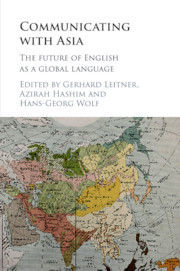
-
Select format
-
- Publisher:
- Cambridge University Press
- Publication date:
- January 2016
- January 2016
- ISBN:
- 9781107477186
- 9781107062610
- 9781107666054
- Dimensions:
- (228 x 152 mm)
- Weight & Pages:
- 0.71kg, 384 Pages
- Dimensions:
- (229 x 152 mm)
- Weight & Pages:
- 0.54kg, 384 Pages
You may already have access via personal or institutional login
Book description
Communicating with Asia brings together an international team of leading researchers to discuss South, South-East, East and Central Asia, and explore Mandarin, Cantonese, Hindi-Urdu, Malay, and Russian as major languages. The volume locates English inside a number of national, regional or lingua franca contexts and illustrates the way it develops in such contact situations. Local dynamics affecting languages in contact and cultural links of languages are dealt with, such as educational-political issues and tensions between conflicting norms. In today's global world, where the continent is an increasing area of focus, it is vital to explore what it means to 'understand' Asian cultures through English and other languages. This important new study will be of interest to students and researchers working in the fields of regional studies, English as a global language, Asian languages and cultural studies.
Reviews
'… it is a robust collection of papers that can greatly inform Asia-focused researchers and linguistic knowledge. Moreover, it can serve as a model of good research for individuals working in different sub-fields of applied linguistics - from ELF to world Englishes to language policy and planning. I would say, that if this is where your core research interest lies, this is a book that certainly should have a home on your bookshelf.'
Joshua M. Paiz Source: LINGUIST List (https://new.linguistlist.org)
Contents
Metrics
Full text views
Full text views help Loading metrics...
Loading metrics...
* Views captured on Cambridge Core between #date#. This data will be updated every 24 hours.
Usage data cannot currently be displayed.
Accessibility standard: Unknown
Why this information is here
This section outlines the accessibility features of this content - including support for screen readers, full keyboard navigation and high-contrast display options. This may not be relevant for you.
Accessibility Information
Accessibility compliance for the PDF of this book is currently unknown and may be updated in the future.


